Executive Remuneration, Corporate Governance, and Company Performance
VerifiedAdded on 2021/04/24
|11
|2397
|23
Report
AI Summary
This report provides a comprehensive analysis of executive remuneration and its intricate relationship with corporate governance and company performance. It begins with an executive summary highlighting the controversies surrounding executive compensation, including basic salary, bonuses, stock options, and other benefits. The introduction sets the stage by discussing the public and regulatory attention drawn to executive pay, especially in light of high-profile organizational failures. The report delves into the components of executive remuneration and relevant theoretical perspectives, particularly agency theory, which explains the separation of ownership and control. It then examines the relationship between executive compensation and company performance, exploring different performance measures and the causes for misalignment between executive pay and organizational objectives. The report also discusses the impact of poor performance on executive compensation. Finally, the conclusion synthesizes the key findings, emphasizing the importance of proper governance in executive compensation packages and the role of the board of directors in monitoring executive pay.

Running Head: Corporate Governance 1
Corporate Governance
Corporate Governance
Paraphrase This Document
Need a fresh take? Get an instant paraphrase of this document with our AI Paraphraser
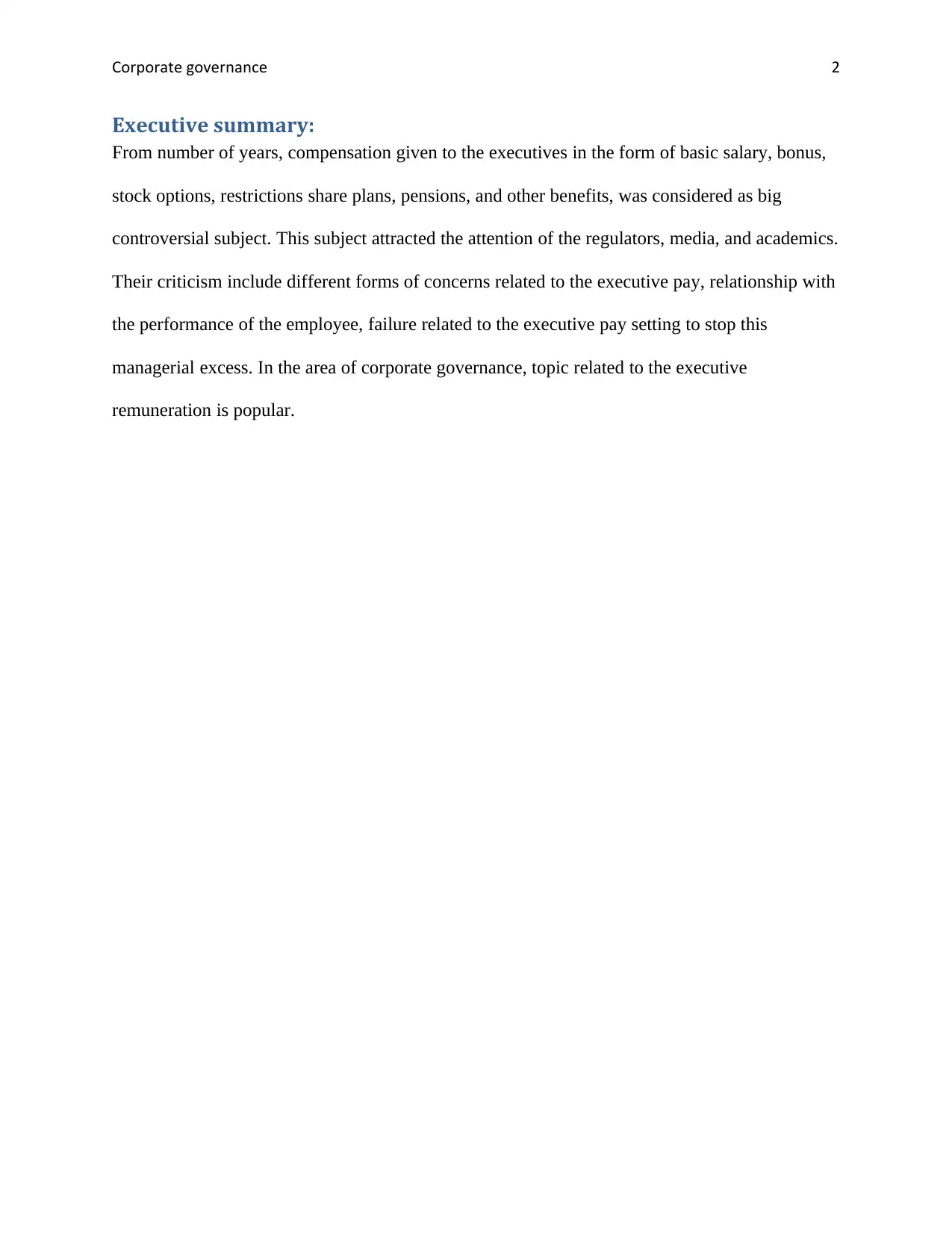
Corporate governance 2
Executive summary:
From number of years, compensation given to the executives in the form of basic salary, bonus,
stock options, restrictions share plans, pensions, and other benefits, was considered as big
controversial subject. This subject attracted the attention of the regulators, media, and academics.
Their criticism include different forms of concerns related to the executive pay, relationship with
the performance of the employee, failure related to the executive pay setting to stop this
managerial excess. In the area of corporate governance, topic related to the executive
remuneration is popular.
Executive summary:
From number of years, compensation given to the executives in the form of basic salary, bonus,
stock options, restrictions share plans, pensions, and other benefits, was considered as big
controversial subject. This subject attracted the attention of the regulators, media, and academics.
Their criticism include different forms of concerns related to the executive pay, relationship with
the performance of the employee, failure related to the executive pay setting to stop this
managerial excess. In the area of corporate governance, topic related to the executive
remuneration is popular.
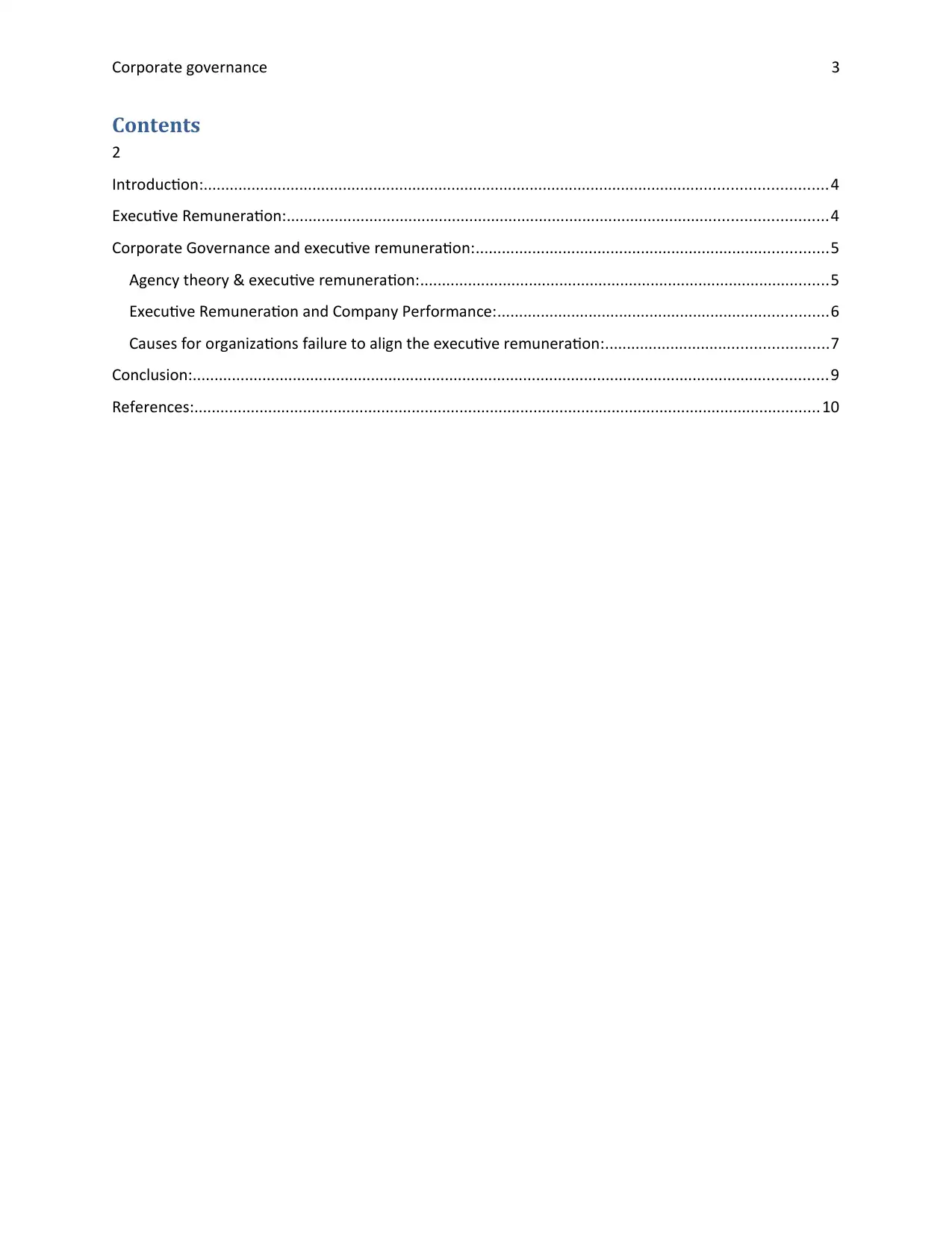
Corporate governance 3
Contents
2
Introduction:...............................................................................................................................................4
Executive Remuneration:............................................................................................................................4
Corporate Governance and executive remuneration:.................................................................................5
Agency theory & executive remuneration:..............................................................................................5
Executive Remuneration and Company Performance:............................................................................6
Causes for organizations failure to align the executive remuneration:...................................................7
Conclusion:..................................................................................................................................................9
References:................................................................................................................................................10
Contents
2
Introduction:...............................................................................................................................................4
Executive Remuneration:............................................................................................................................4
Corporate Governance and executive remuneration:.................................................................................5
Agency theory & executive remuneration:..............................................................................................5
Executive Remuneration and Company Performance:............................................................................6
Causes for organizations failure to align the executive remuneration:...................................................7
Conclusion:..................................................................................................................................................9
References:................................................................................................................................................10
⊘ This is a preview!⊘
Do you want full access?
Subscribe today to unlock all pages.

Trusted by 1+ million students worldwide
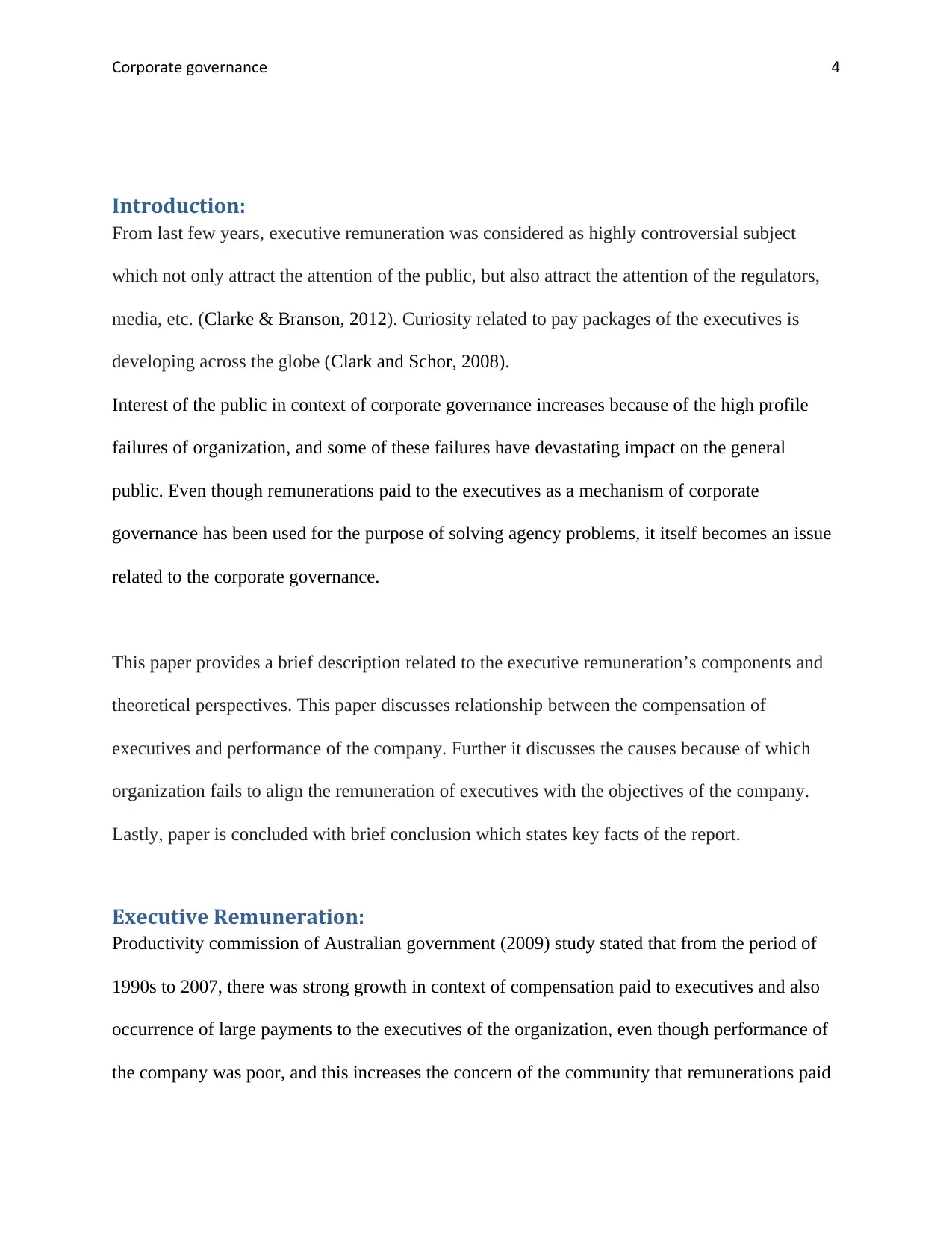
Corporate governance 4
Introduction:
From last few years, executive remuneration was considered as highly controversial subject
which not only attract the attention of the public, but also attract the attention of the regulators,
media, etc. (Clarke & Branson, 2012). Curiosity related to pay packages of the executives is
developing across the globe (Clark and Schor, 2008).
Interest of the public in context of corporate governance increases because of the high profile
failures of organization, and some of these failures have devastating impact on the general
public. Even though remunerations paid to the executives as a mechanism of corporate
governance has been used for the purpose of solving agency problems, it itself becomes an issue
related to the corporate governance.
This paper provides a brief description related to the executive remuneration’s components and
theoretical perspectives. This paper discusses relationship between the compensation of
executives and performance of the company. Further it discusses the causes because of which
organization fails to align the remuneration of executives with the objectives of the company.
Lastly, paper is concluded with brief conclusion which states key facts of the report.
Executive Remuneration:
Productivity commission of Australian government (2009) study stated that from the period of
1990s to 2007, there was strong growth in context of compensation paid to executives and also
occurrence of large payments to the executives of the organization, even though performance of
the company was poor, and this increases the concern of the community that remunerations paid
Introduction:
From last few years, executive remuneration was considered as highly controversial subject
which not only attract the attention of the public, but also attract the attention of the regulators,
media, etc. (Clarke & Branson, 2012). Curiosity related to pay packages of the executives is
developing across the globe (Clark and Schor, 2008).
Interest of the public in context of corporate governance increases because of the high profile
failures of organization, and some of these failures have devastating impact on the general
public. Even though remunerations paid to the executives as a mechanism of corporate
governance has been used for the purpose of solving agency problems, it itself becomes an issue
related to the corporate governance.
This paper provides a brief description related to the executive remuneration’s components and
theoretical perspectives. This paper discusses relationship between the compensation of
executives and performance of the company. Further it discusses the causes because of which
organization fails to align the remuneration of executives with the objectives of the company.
Lastly, paper is concluded with brief conclusion which states key facts of the report.
Executive Remuneration:
Productivity commission of Australian government (2009) study stated that from the period of
1990s to 2007, there was strong growth in context of compensation paid to executives and also
occurrence of large payments to the executives of the organization, even though performance of
the company was poor, and this increases the concern of the community that remunerations paid
Paraphrase This Document
Need a fresh take? Get an instant paraphrase of this document with our AI Paraphraser
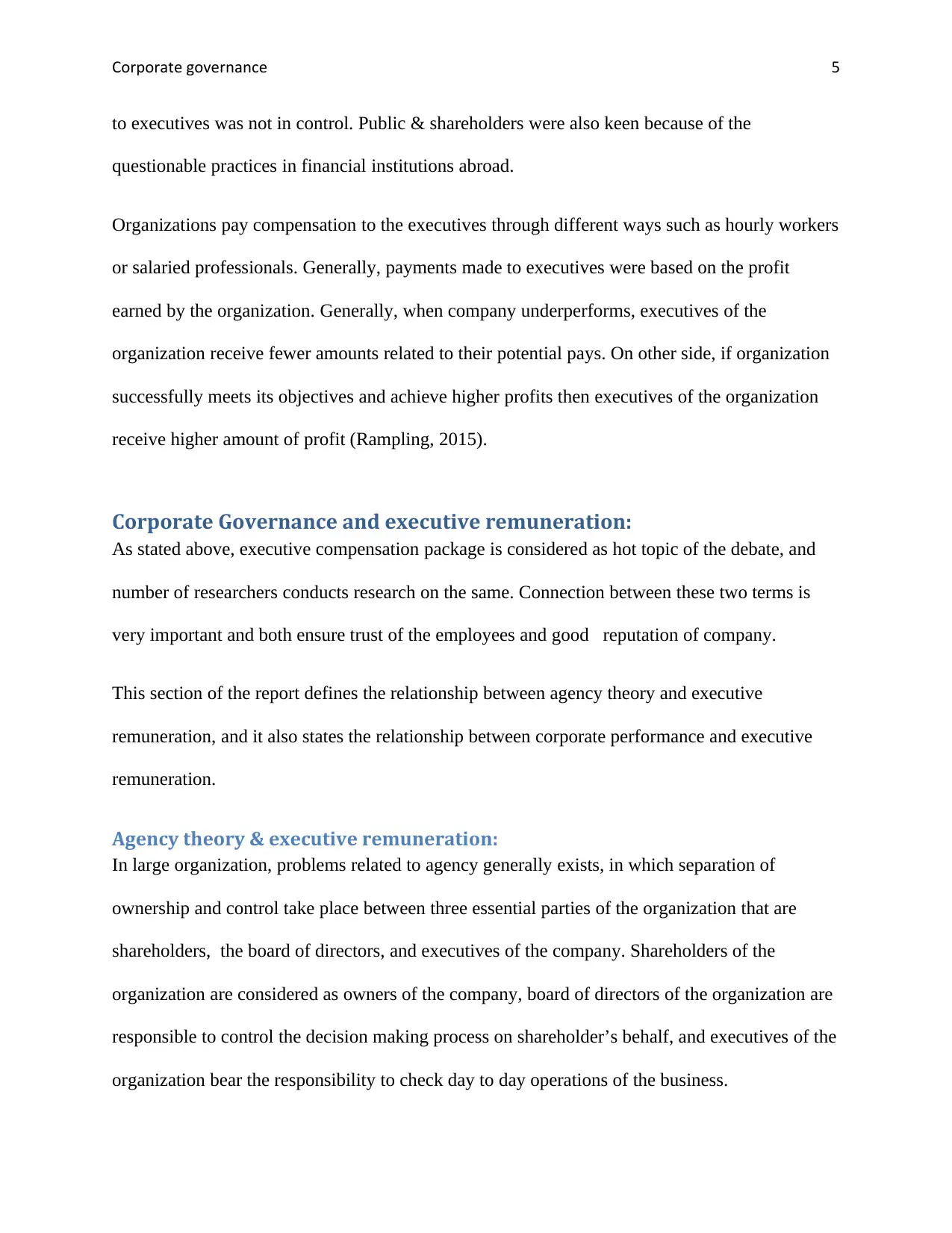
Corporate governance 5
to executives was not in control. Public & shareholders were also keen because of the
questionable practices in financial institutions abroad.
Organizations pay compensation to the executives through different ways such as hourly workers
or salaried professionals. Generally, payments made to executives were based on the profit
earned by the organization. Generally, when company underperforms, executives of the
organization receive fewer amounts related to their potential pays. On other side, if organization
successfully meets its objectives and achieve higher profits then executives of the organization
receive higher amount of profit (Rampling, 2015).
Corporate Governance and executive remuneration:
As stated above, executive compensation package is considered as hot topic of the debate, and
number of researchers conducts research on the same. Connection between these two terms is
very important and both ensure trust of the employees and good reputation of company.
This section of the report defines the relationship between agency theory and executive
remuneration, and it also states the relationship between corporate performance and executive
remuneration.
Agency theory & executive remuneration:
In large organization, problems related to agency generally exists, in which separation of
ownership and control take place between three essential parties of the organization that are
shareholders, the board of directors, and executives of the company. Shareholders of the
organization are considered as owners of the company, board of directors of the organization are
responsible to control the decision making process on shareholder’s behalf, and executives of the
organization bear the responsibility to check day to day operations of the business.
to executives was not in control. Public & shareholders were also keen because of the
questionable practices in financial institutions abroad.
Organizations pay compensation to the executives through different ways such as hourly workers
or salaried professionals. Generally, payments made to executives were based on the profit
earned by the organization. Generally, when company underperforms, executives of the
organization receive fewer amounts related to their potential pays. On other side, if organization
successfully meets its objectives and achieve higher profits then executives of the organization
receive higher amount of profit (Rampling, 2015).
Corporate Governance and executive remuneration:
As stated above, executive compensation package is considered as hot topic of the debate, and
number of researchers conducts research on the same. Connection between these two terms is
very important and both ensure trust of the employees and good reputation of company.
This section of the report defines the relationship between agency theory and executive
remuneration, and it also states the relationship between corporate performance and executive
remuneration.
Agency theory & executive remuneration:
In large organization, problems related to agency generally exists, in which separation of
ownership and control take place between three essential parties of the organization that are
shareholders, the board of directors, and executives of the company. Shareholders of the
organization are considered as owners of the company, board of directors of the organization are
responsible to control the decision making process on shareholder’s behalf, and executives of the
organization bear the responsibility to check day to day operations of the business.
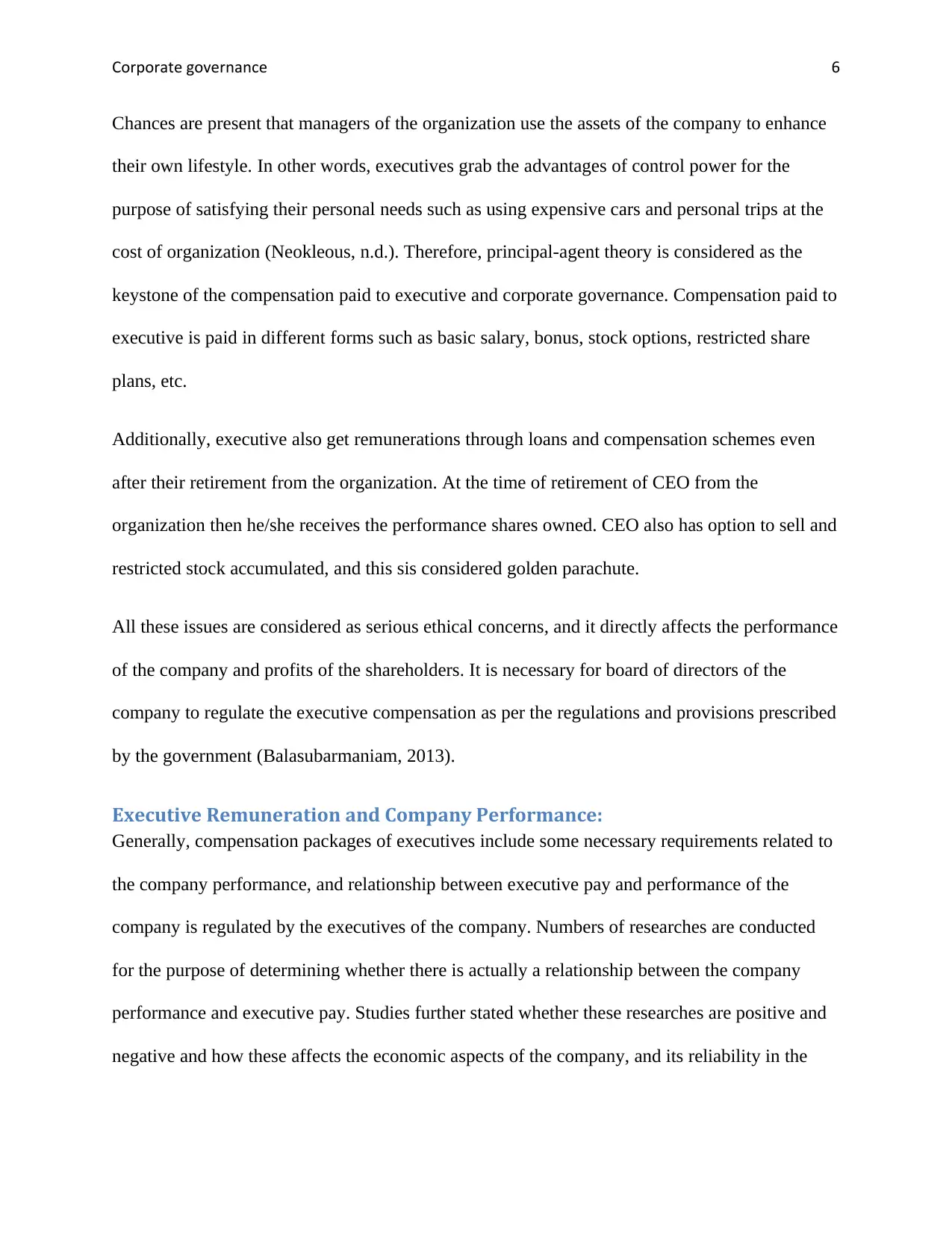
Corporate governance 6
Chances are present that managers of the organization use the assets of the company to enhance
their own lifestyle. In other words, executives grab the advantages of control power for the
purpose of satisfying their personal needs such as using expensive cars and personal trips at the
cost of organization (Neokleous, n.d.). Therefore, principal-agent theory is considered as the
keystone of the compensation paid to executive and corporate governance. Compensation paid to
executive is paid in different forms such as basic salary, bonus, stock options, restricted share
plans, etc.
Additionally, executive also get remunerations through loans and compensation schemes even
after their retirement from the organization. At the time of retirement of CEO from the
organization then he/she receives the performance shares owned. CEO also has option to sell and
restricted stock accumulated, and this sis considered golden parachute.
All these issues are considered as serious ethical concerns, and it directly affects the performance
of the company and profits of the shareholders. It is necessary for board of directors of the
company to regulate the executive compensation as per the regulations and provisions prescribed
by the government (Balasubarmaniam, 2013).
Executive Remuneration and Company Performance:
Generally, compensation packages of executives include some necessary requirements related to
the company performance, and relationship between executive pay and performance of the
company is regulated by the executives of the company. Numbers of researches are conducted
for the purpose of determining whether there is actually a relationship between the company
performance and executive pay. Studies further stated whether these researches are positive and
negative and how these affects the economic aspects of the company, and its reliability in the
Chances are present that managers of the organization use the assets of the company to enhance
their own lifestyle. In other words, executives grab the advantages of control power for the
purpose of satisfying their personal needs such as using expensive cars and personal trips at the
cost of organization (Neokleous, n.d.). Therefore, principal-agent theory is considered as the
keystone of the compensation paid to executive and corporate governance. Compensation paid to
executive is paid in different forms such as basic salary, bonus, stock options, restricted share
plans, etc.
Additionally, executive also get remunerations through loans and compensation schemes even
after their retirement from the organization. At the time of retirement of CEO from the
organization then he/she receives the performance shares owned. CEO also has option to sell and
restricted stock accumulated, and this sis considered golden parachute.
All these issues are considered as serious ethical concerns, and it directly affects the performance
of the company and profits of the shareholders. It is necessary for board of directors of the
company to regulate the executive compensation as per the regulations and provisions prescribed
by the government (Balasubarmaniam, 2013).
Executive Remuneration and Company Performance:
Generally, compensation packages of executives include some necessary requirements related to
the company performance, and relationship between executive pay and performance of the
company is regulated by the executives of the company. Numbers of researches are conducted
for the purpose of determining whether there is actually a relationship between the company
performance and executive pay. Studies further stated whether these researches are positive and
negative and how these affects the economic aspects of the company, and its reliability in the
⊘ This is a preview!⊘
Do you want full access?
Subscribe today to unlock all pages.

Trusted by 1+ million students worldwide
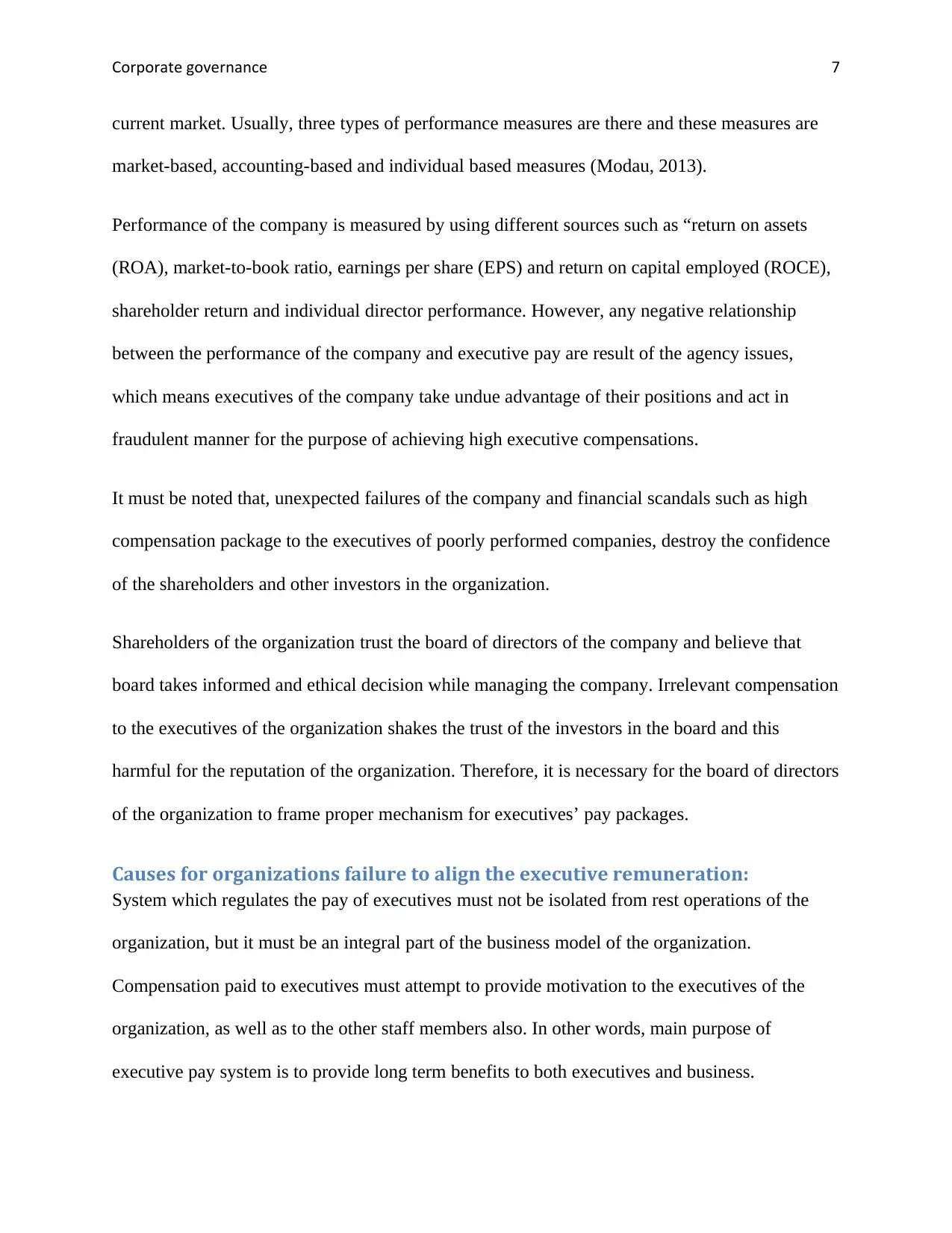
Corporate governance 7
current market. Usually, three types of performance measures are there and these measures are
market-based, accounting-based and individual based measures (Modau, 2013).
Performance of the company is measured by using different sources such as “return on assets
(ROA), market-to-book ratio, earnings per share (EPS) and return on capital employed (ROCE),
shareholder return and individual director performance. However, any negative relationship
between the performance of the company and executive pay are result of the agency issues,
which means executives of the company take undue advantage of their positions and act in
fraudulent manner for the purpose of achieving high executive compensations.
It must be noted that, unexpected failures of the company and financial scandals such as high
compensation package to the executives of poorly performed companies, destroy the confidence
of the shareholders and other investors in the organization.
Shareholders of the organization trust the board of directors of the company and believe that
board takes informed and ethical decision while managing the company. Irrelevant compensation
to the executives of the organization shakes the trust of the investors in the board and this
harmful for the reputation of the organization. Therefore, it is necessary for the board of directors
of the organization to frame proper mechanism for executives’ pay packages.
Causes for organizations failure to align the executive remuneration:
System which regulates the pay of executives must not be isolated from rest operations of the
organization, but it must be an integral part of the business model of the organization.
Compensation paid to executives must attempt to provide motivation to the executives of the
organization, as well as to the other staff members also. In other words, main purpose of
executive pay system is to provide long term benefits to both executives and business.
current market. Usually, three types of performance measures are there and these measures are
market-based, accounting-based and individual based measures (Modau, 2013).
Performance of the company is measured by using different sources such as “return on assets
(ROA), market-to-book ratio, earnings per share (EPS) and return on capital employed (ROCE),
shareholder return and individual director performance. However, any negative relationship
between the performance of the company and executive pay are result of the agency issues,
which means executives of the company take undue advantage of their positions and act in
fraudulent manner for the purpose of achieving high executive compensations.
It must be noted that, unexpected failures of the company and financial scandals such as high
compensation package to the executives of poorly performed companies, destroy the confidence
of the shareholders and other investors in the organization.
Shareholders of the organization trust the board of directors of the company and believe that
board takes informed and ethical decision while managing the company. Irrelevant compensation
to the executives of the organization shakes the trust of the investors in the board and this
harmful for the reputation of the organization. Therefore, it is necessary for the board of directors
of the organization to frame proper mechanism for executives’ pay packages.
Causes for organizations failure to align the executive remuneration:
System which regulates the pay of executives must not be isolated from rest operations of the
organization, but it must be an integral part of the business model of the organization.
Compensation paid to executives must attempt to provide motivation to the executives of the
organization, as well as to the other staff members also. In other words, main purpose of
executive pay system is to provide long term benefits to both executives and business.
Paraphrase This Document
Need a fresh take? Get an instant paraphrase of this document with our AI Paraphraser

Corporate governance 8
Additionally, these systems must be fair in nature and related to the actual effort and success of
the organization.
There is no universal method which provides the way through which remuneration package of he
executives can be mapped with the value and efforts of the organization. Various researches
stated that human resources and their judgments play most important role, and there efforts can
be considered as quantitative measurements for the purpose of designing proper risk adjusted pay
systems. The first and most important step for establishing the reliability is to seek proper
balance between the fixed and variable elements of any plan. Following are causes because of
which organizations fails to align the executive remuneration with the objectives of the
company:
Organization does not provide recorded salaries and bonuses to their employees: as stated
above, from the period of 1990s to 2007, there was strong growth in context of compensation
paid to executives and also occurrence of large payments to the executives of the organization,
even though performance of the company was poor. Executives of the organization do not
receive the amount which is actually recorded in the books, but they are receiving much higher
amount than this. Executive of the organization fails to fulfill their responsibility towards the
organization, shareholders, and other stakeholders. This is considered as biggest reason (SAPP,
2006).
An annual change in the compensation packages does not show any changes in the
performance of the company: generally, executives charge their remuneration as per the
performance of the company, which means if company performs good then executives charge
high amount as compensation, and if company performs bad then executive charge les amount.
Additionally, these systems must be fair in nature and related to the actual effort and success of
the organization.
There is no universal method which provides the way through which remuneration package of he
executives can be mapped with the value and efforts of the organization. Various researches
stated that human resources and their judgments play most important role, and there efforts can
be considered as quantitative measurements for the purpose of designing proper risk adjusted pay
systems. The first and most important step for establishing the reliability is to seek proper
balance between the fixed and variable elements of any plan. Following are causes because of
which organizations fails to align the executive remuneration with the objectives of the
company:
Organization does not provide recorded salaries and bonuses to their employees: as stated
above, from the period of 1990s to 2007, there was strong growth in context of compensation
paid to executives and also occurrence of large payments to the executives of the organization,
even though performance of the company was poor. Executives of the organization do not
receive the amount which is actually recorded in the books, but they are receiving much higher
amount than this. Executive of the organization fails to fulfill their responsibility towards the
organization, shareholders, and other stakeholders. This is considered as biggest reason (SAPP,
2006).
An annual change in the compensation packages does not show any changes in the
performance of the company: generally, executives charge their remuneration as per the
performance of the company, which means if company performs good then executives charge
high amount as compensation, and if company performs bad then executive charge les amount.
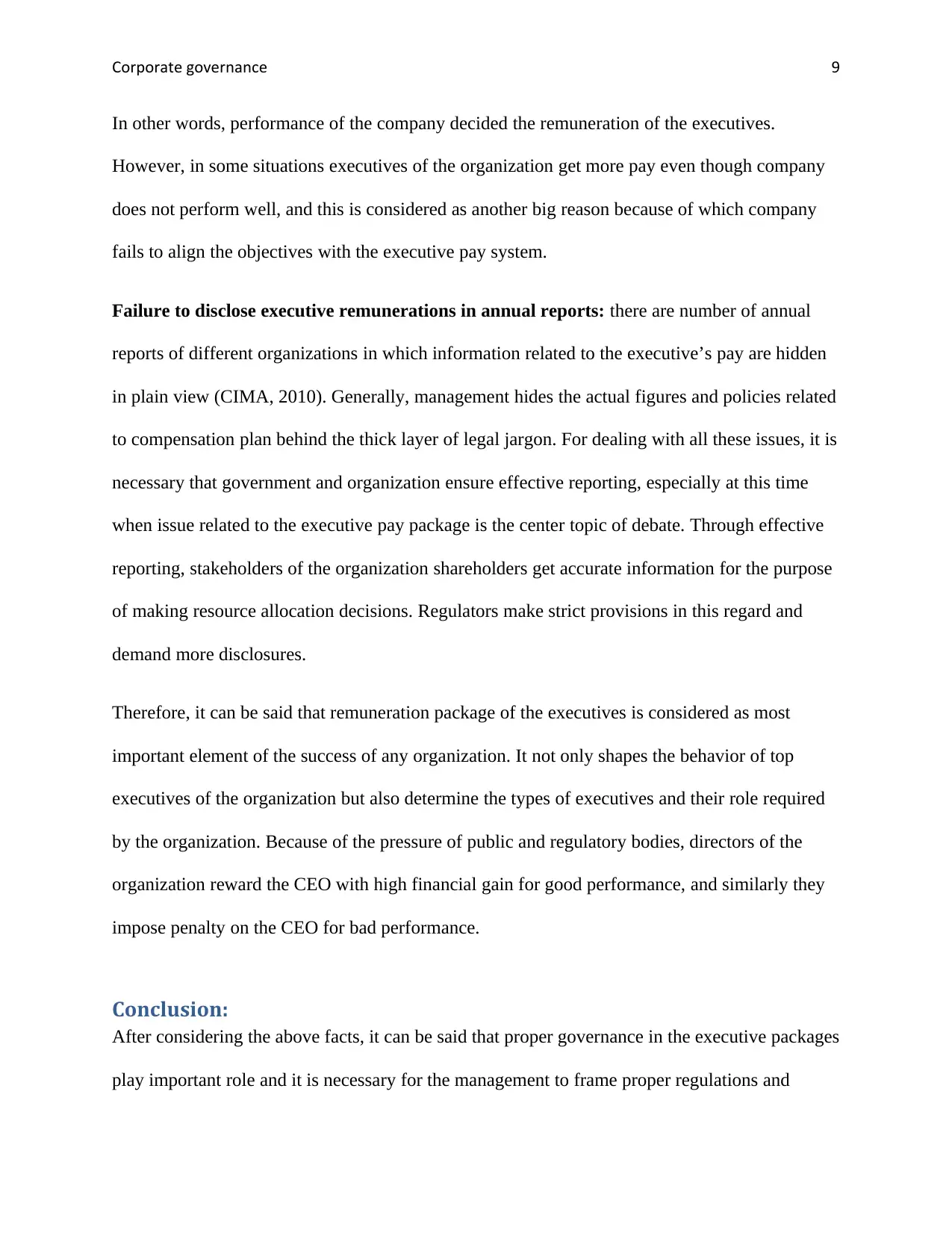
Corporate governance 9
In other words, performance of the company decided the remuneration of the executives.
However, in some situations executives of the organization get more pay even though company
does not perform well, and this is considered as another big reason because of which company
fails to align the objectives with the executive pay system.
Failure to disclose executive remunerations in annual reports: there are number of annual
reports of different organizations in which information related to the executive’s pay are hidden
in plain view (CIMA, 2010). Generally, management hides the actual figures and policies related
to compensation plan behind the thick layer of legal jargon. For dealing with all these issues, it is
necessary that government and organization ensure effective reporting, especially at this time
when issue related to the executive pay package is the center topic of debate. Through effective
reporting, stakeholders of the organization shareholders get accurate information for the purpose
of making resource allocation decisions. Regulators make strict provisions in this regard and
demand more disclosures.
Therefore, it can be said that remuneration package of the executives is considered as most
important element of the success of any organization. It not only shapes the behavior of top
executives of the organization but also determine the types of executives and their role required
by the organization. Because of the pressure of public and regulatory bodies, directors of the
organization reward the CEO with high financial gain for good performance, and similarly they
impose penalty on the CEO for bad performance.
Conclusion:
After considering the above facts, it can be said that proper governance in the executive packages
play important role and it is necessary for the management to frame proper regulations and
In other words, performance of the company decided the remuneration of the executives.
However, in some situations executives of the organization get more pay even though company
does not perform well, and this is considered as another big reason because of which company
fails to align the objectives with the executive pay system.
Failure to disclose executive remunerations in annual reports: there are number of annual
reports of different organizations in which information related to the executive’s pay are hidden
in plain view (CIMA, 2010). Generally, management hides the actual figures and policies related
to compensation plan behind the thick layer of legal jargon. For dealing with all these issues, it is
necessary that government and organization ensure effective reporting, especially at this time
when issue related to the executive pay package is the center topic of debate. Through effective
reporting, stakeholders of the organization shareholders get accurate information for the purpose
of making resource allocation decisions. Regulators make strict provisions in this regard and
demand more disclosures.
Therefore, it can be said that remuneration package of the executives is considered as most
important element of the success of any organization. It not only shapes the behavior of top
executives of the organization but also determine the types of executives and their role required
by the organization. Because of the pressure of public and regulatory bodies, directors of the
organization reward the CEO with high financial gain for good performance, and similarly they
impose penalty on the CEO for bad performance.
Conclusion:
After considering the above facts, it can be said that proper governance in the executive packages
play important role and it is necessary for the management to frame proper regulations and
⊘ This is a preview!⊘
Do you want full access?
Subscribe today to unlock all pages.

Trusted by 1+ million students worldwide
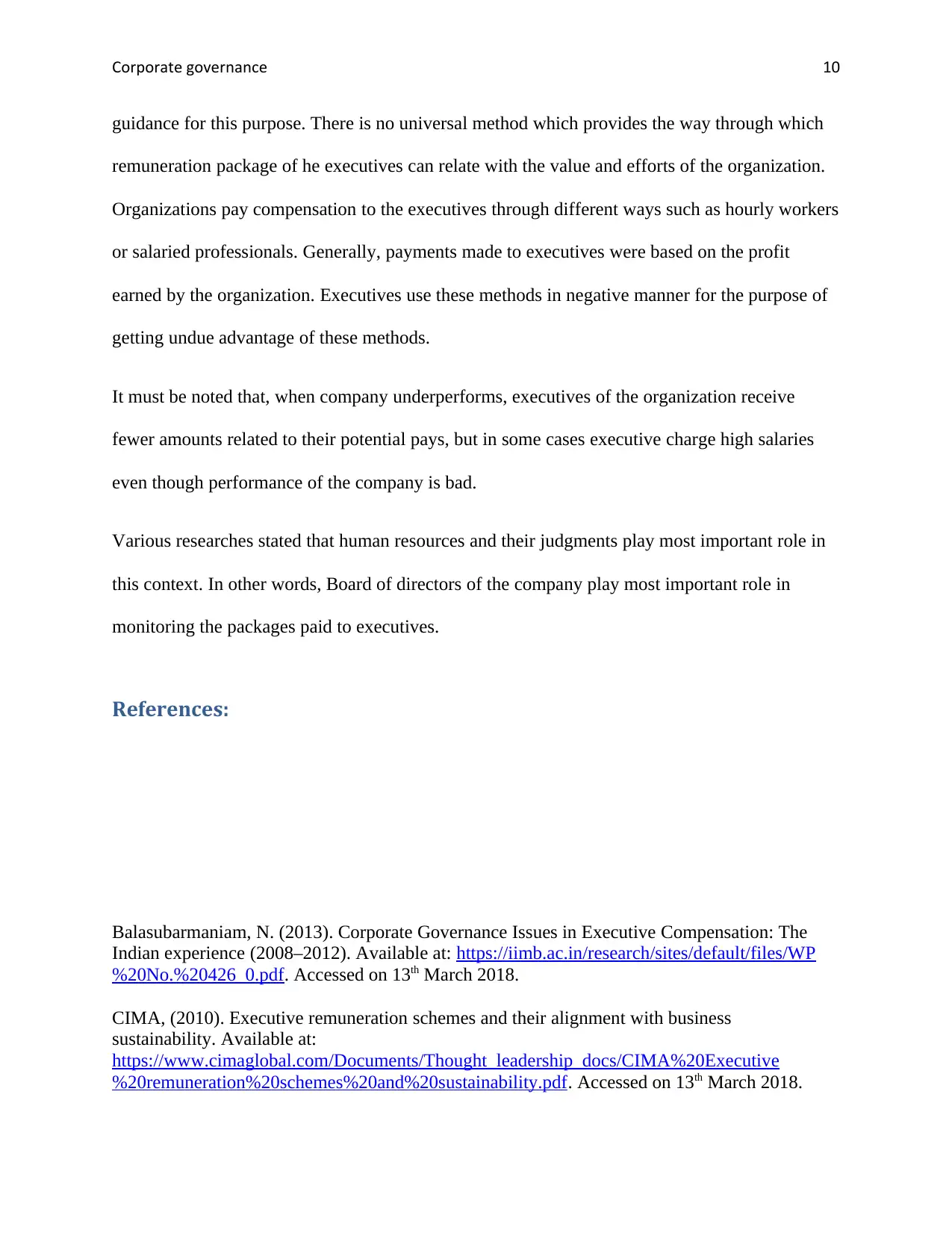
Corporate governance 10
guidance for this purpose. There is no universal method which provides the way through which
remuneration package of he executives can relate with the value and efforts of the organization.
Organizations pay compensation to the executives through different ways such as hourly workers
or salaried professionals. Generally, payments made to executives were based on the profit
earned by the organization. Executives use these methods in negative manner for the purpose of
getting undue advantage of these methods.
It must be noted that, when company underperforms, executives of the organization receive
fewer amounts related to their potential pays, but in some cases executive charge high salaries
even though performance of the company is bad.
Various researches stated that human resources and their judgments play most important role in
this context. In other words, Board of directors of the company play most important role in
monitoring the packages paid to executives.
References:
Balasubarmaniam, N. (2013). Corporate Governance Issues in Executive Compensation: The
Indian experience (2008–2012). Available at: https://iimb.ac.in/research/sites/default/files/WP
%20No.%20426_0.pdf. Accessed on 13th March 2018.
CIMA, (2010). Executive remuneration schemes and their alignment with business
sustainability. Available at:
https://www.cimaglobal.com/Documents/Thought_leadership_docs/CIMA%20Executive
%20remuneration%20schemes%20and%20sustainability.pdf. Accessed on 13th March 2018.
guidance for this purpose. There is no universal method which provides the way through which
remuneration package of he executives can relate with the value and efforts of the organization.
Organizations pay compensation to the executives through different ways such as hourly workers
or salaried professionals. Generally, payments made to executives were based on the profit
earned by the organization. Executives use these methods in negative manner for the purpose of
getting undue advantage of these methods.
It must be noted that, when company underperforms, executives of the organization receive
fewer amounts related to their potential pays, but in some cases executive charge high salaries
even though performance of the company is bad.
Various researches stated that human resources and their judgments play most important role in
this context. In other words, Board of directors of the company play most important role in
monitoring the packages paid to executives.
References:
Balasubarmaniam, N. (2013). Corporate Governance Issues in Executive Compensation: The
Indian experience (2008–2012). Available at: https://iimb.ac.in/research/sites/default/files/WP
%20No.%20426_0.pdf. Accessed on 13th March 2018.
CIMA, (2010). Executive remuneration schemes and their alignment with business
sustainability. Available at:
https://www.cimaglobal.com/Documents/Thought_leadership_docs/CIMA%20Executive
%20remuneration%20schemes%20and%20sustainability.pdf. Accessed on 13th March 2018.
Paraphrase This Document
Need a fresh take? Get an instant paraphrase of this document with our AI Paraphraser
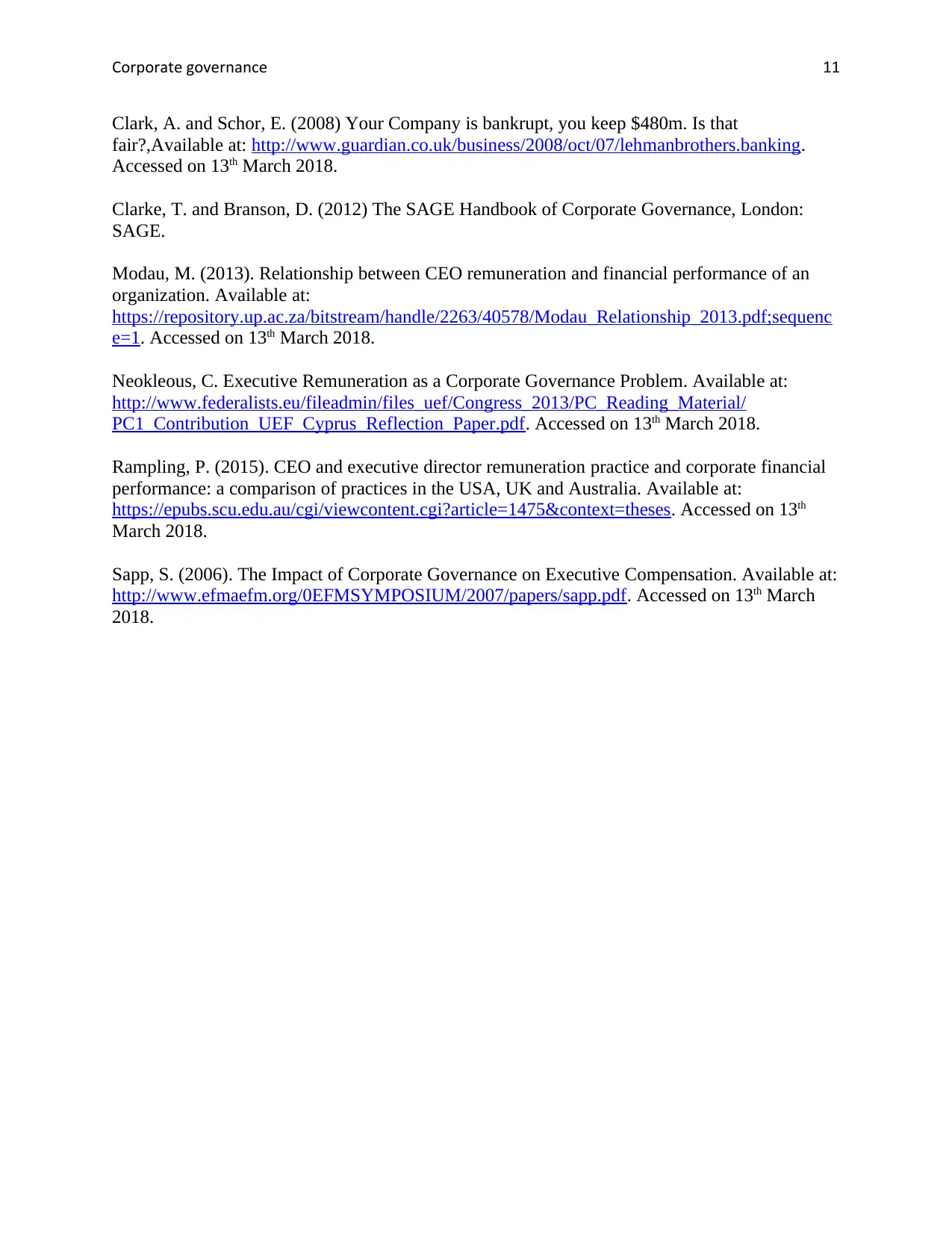
Corporate governance 11
Clark, A. and Schor, E. (2008) Your Company is bankrupt, you keep $480m. Is that
fair?,Available at: http://www.guardian.co.uk/business/2008/oct/07/lehmanbrothers.banking.
Accessed on 13th March 2018.
Clarke, T. and Branson, D. (2012) The SAGE Handbook of Corporate Governance, London:
SAGE.
Modau, M. (2013). Relationship between CEO remuneration and financial performance of an
organization. Available at:
https://repository.up.ac.za/bitstream/handle/2263/40578/Modau_Relationship_2013.pdf;sequenc
e=1. Accessed on 13th March 2018.
Neokleous, C. Executive Remuneration as a Corporate Governance Problem. Available at:
http://www.federalists.eu/fileadmin/files_uef/Congress_2013/PC_Reading_Material/
PC1_Contribution_UEF_Cyprus_Reflection_Paper.pdf. Accessed on 13th March 2018.
Rampling, P. (2015). CEO and executive director remuneration practice and corporate financial
performance: a comparison of practices in the USA, UK and Australia. Available at:
https://epubs.scu.edu.au/cgi/viewcontent.cgi?article=1475&context=theses. Accessed on 13th
March 2018.
Sapp, S. (2006). The Impact of Corporate Governance on Executive Compensation. Available at:
http://www.efmaefm.org/0EFMSYMPOSIUM/2007/papers/sapp.pdf. Accessed on 13th March
2018.
Clark, A. and Schor, E. (2008) Your Company is bankrupt, you keep $480m. Is that
fair?,Available at: http://www.guardian.co.uk/business/2008/oct/07/lehmanbrothers.banking.
Accessed on 13th March 2018.
Clarke, T. and Branson, D. (2012) The SAGE Handbook of Corporate Governance, London:
SAGE.
Modau, M. (2013). Relationship between CEO remuneration and financial performance of an
organization. Available at:
https://repository.up.ac.za/bitstream/handle/2263/40578/Modau_Relationship_2013.pdf;sequenc
e=1. Accessed on 13th March 2018.
Neokleous, C. Executive Remuneration as a Corporate Governance Problem. Available at:
http://www.federalists.eu/fileadmin/files_uef/Congress_2013/PC_Reading_Material/
PC1_Contribution_UEF_Cyprus_Reflection_Paper.pdf. Accessed on 13th March 2018.
Rampling, P. (2015). CEO and executive director remuneration practice and corporate financial
performance: a comparison of practices in the USA, UK and Australia. Available at:
https://epubs.scu.edu.au/cgi/viewcontent.cgi?article=1475&context=theses. Accessed on 13th
March 2018.
Sapp, S. (2006). The Impact of Corporate Governance on Executive Compensation. Available at:
http://www.efmaefm.org/0EFMSYMPOSIUM/2007/papers/sapp.pdf. Accessed on 13th March
2018.
1 out of 11
Related Documents
Your All-in-One AI-Powered Toolkit for Academic Success.
+13062052269
info@desklib.com
Available 24*7 on WhatsApp / Email
![[object Object]](/_next/static/media/star-bottom.7253800d.svg)
Unlock your academic potential
Copyright © 2020–2025 A2Z Services. All Rights Reserved. Developed and managed by ZUCOL.





